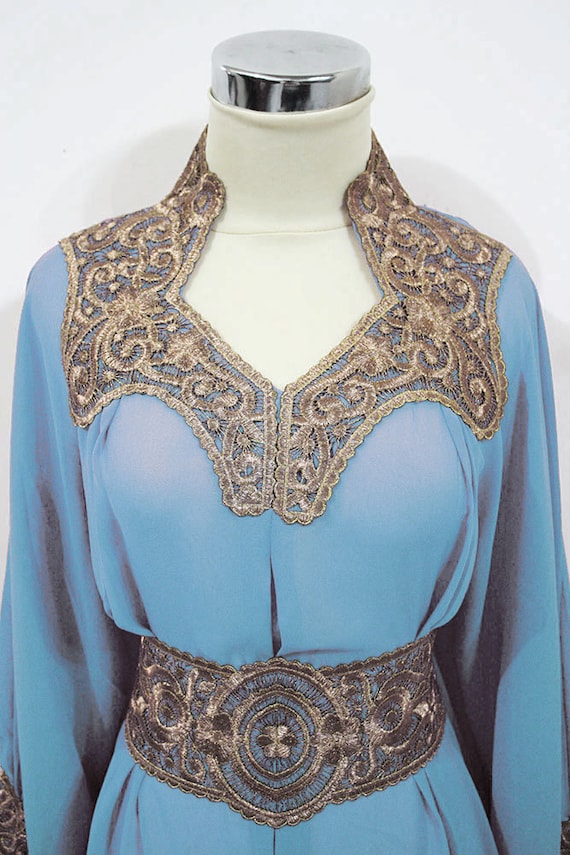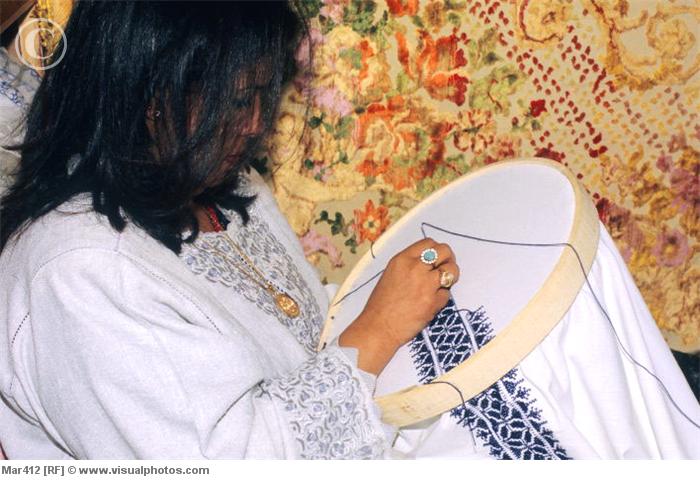 |
| Moroccan Caftan BABY BLUE Sheer Chiffon Fancy Gold Embroidery Available on Etsy.com |
There are many regional styles of
textile weaving and embroidery patterns, and it is almost exclusively done by
women. What is often over looked however the duality between man and woman is
during the making of the textiles. The relationship between the men and the
women working together to provide each other with social status, material
subsistence and opportunity for economic and creative development plays out in many
ways in Moroccan society, and few more direct than in the production of
textiles. The necessary skills, knowledge, and creativity necessary for weaving
will ensure the future success to the artisan personally, as well as to the
entire community at large
Textiles allow women a certain
degree of freedom for expression, despite conservative design traditions (Jereb
1996, 44) .
In the modern relationship between tattoo and textile, a weaver may incorporate
a tattoo into a textile design which corresponds to a particular part of her
body. The Berbers say that “no two rugs are ever alike” as the weaving of rugs
and textiles are an opportunity for women to fully express their creativity -
“a freedom entrenched in the most ancient traditions” (Jereb 1996, 44) . The vocabulary of
an accomplished weaver must be extensive, including intricate geometric shapes,
natural symbols like flora, and natural representations of animals (Jereb 1996, 45) . However, it is the
tattoo that makes the textile personal, unique and complete. An example of this
is in the placement of the symbol. The placement of the tattoo symbol in the
rug may even correspond to the placement of the tattoo on the woman`s body (Jereb 1996, 47) . By imprinting a
personal motif into a textile, in a position corresponding to the body, the
weaver, or embroiderer, has visually and spiritually extended herself beyond
her own body into this material that is meant to act as a protective shield
from the world. Therefore, in a metaphorical sense, the artisan has made it so
that the owner of the rug will be protected by the artist herself, building a
bond between rug owner and creator.
In urban areas, the
specialization of weaving is centered in weavers who weaver for a profession,
travelling from town to town, unrestrained by the social and residential limits
women experience in rural areas (Jereb 1996, 47) . Despite these
restrictions in rural areas, the women find ways of making weaving an enjoyable
activity. In the rural areas, women gather particularly for the purpose of
weaving. They will sing and chant of times of romance and plenty, telling
stories of superstition and magic, working diligently (Jereb 1996, 48) . These women will
weave the tent clothes, the furnishing for the home, all the decorative
materials, assisted by their daughters and young girls of the band who are in
the process of learning the craft (Jereb 1996, 48) . The necessity of knowing the skill is
one which ensures a girl’s prospects in the future. It is an age old tradition,
passed down from one generation to the next, traditionally learned from older
female relatives (Jereb 1996, 48) . The collective
knowledge and skill of the weavers provides resources for future generations to
make the best textile creations they can imagine.
The competency of the weaver
secures her position not only in a social context in the tribe, but ensures her
future. The respect and prestige a woman commands in a community is often
determined by her skill and creativity in her weaving and embroidery
capabilities, ensuring a high bride price (Jereb 1996, 48) . This plays out in a similar farther
for embroidery. Embroidered curtains, intricately decorated with floral motifs,
“hung as decoration on ceremonial occasion, they were the most important items
officially listed in a woman’s dowry” (Jereb 1996, 56) . Without the necessary knowledge,
vocabulary, and skills needed to produce elaborate textiles, the family could experience
shame, and potentially an unmarried daughter.
In contrast to this, if the husband
cannot look after the raw materials needed for textile production, the son’s
family may not be able to marry him off either. The men are the ones who guard and
sheer the sheep needed to make yarn and wool (Jereb 1996, 48) . It depends on the social group which
determines which gender does the washing, spinning, dyeing and drying of the
yarn, however it is usually the women who do it in most Moroccan social groups (Jereb
1996, 48) .
It is very important for the men and women to be proficient at what they do,
whether it be preparing the materials or making the textiles. Without the duality
of the sexes working together a home would not be furnished, the family would
not clothed, and the social value of the family would heavily degrade because
their visual presentation was not up to pare.
 When it
comes to embroidery, the relationship between men and women is a little more
equal comparatively to that of weaving. Embroidery is a primary form of textile
production, present in the urban and rural dwelling landscape, with varying
artistic vocabularies, styles, techniques and materials from city to city
When it
comes to embroidery, the relationship between men and women is a little more
equal comparatively to that of weaving. Embroidery is a primary form of textile
production, present in the urban and rural dwelling landscape, with varying
artistic vocabularies, styles, techniques and materials from city to city
The bond between the weaver and
their craft is one which is incredibly important to develop, for how well they
develop their art will determine their success as a member of their community
and family. Despite the predominantly female presence in textile production,
the success of the trade and the place it holds in Moroccan social life has a dependence
on both men and women working together. The dual bond between the two sexes ensures
the success of the textile production with both genders having assigned roles
regarding who supplies the materials and skills necessary to make the woven and
embroidered fabrics that Morocco is so famous for.

No comments:
Post a Comment